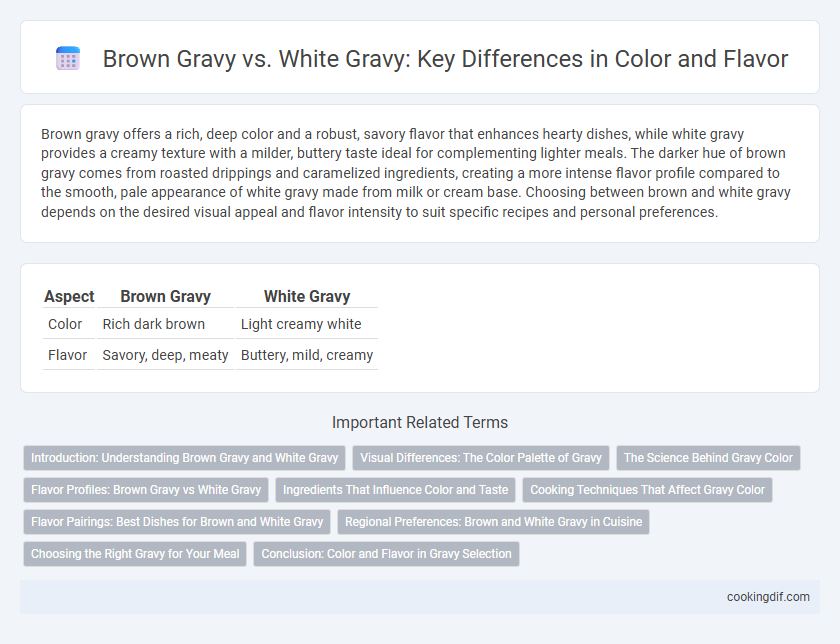Brown gravy offers a rich, deep color and a robust, savory flavor that enhances hearty dishes, while white gravy provides a creamy texture with a milder, buttery taste ideal for complementing lighter meals. The darker hue of brown gravy comes from roasted drippings and caramelized ingredients, creating a more intense flavor profile compared to the smooth, pale appearance of white gravy made from milk or cream base. Choosing between brown and white gravy depends on the desired visual appeal and flavor intensity to suit specific recipes and personal preferences.
Table of Comparison
| Aspect | Brown Gravy | White Gravy |
|---|---|---|
| Color | Rich dark brown | Light creamy white |
| Flavor | Savory, deep, meaty | Buttery, mild, creamy |
Introduction: Understanding Brown Gravy and White Gravy
Brown gravy, characterized by its rich, deep color, is typically made from beef or veal stock combined with browned flour or drippings, delivering a robust, savory flavor. White gravy, often prepared with milk or cream and flour, boasts a pale appearance and a milder, creamier taste that complements poultry and biscuits. Understanding their distinct ingredients and cooking methods highlights the fundamental differences in color and flavor profiles between brown and white gravy.
Visual Differences: The Color Palette of Gravy
Brown gravy showcases a rich, deep mahogany hue derived from roasted meat drippings and caramelized onions, offering a robust, savory flavor. White gravy features a creamy, pale ivory color created by combining milk or cream with a roux, resulting in a smooth, mild taste. These distinct color palettes not only define the visual appeal but also signal the contrasting flavor profiles of each gravy type.
The Science Behind Gravy Color
Brown gravy acquires its deep color and rich flavor from the Maillard reaction during the browning of meat drippings and roux, creating complex compounds that enhance savoriness. White gravy, typically made from milk or cream and a light roux, relies on starch gelatinization without browning, resulting in a pale color and a milder, creamier flavor profile. The chemical processes of caramelization and protein-sugar interactions are key factors that distinguish the appearance and taste of brown versus white gravy.
Flavor Profiles: Brown Gravy vs White Gravy
Brown gravy offers a rich, savory flavor derived from beef or veal drippings, enhanced with caramelized onions and herbs, resulting in a deep umami taste. White gravy, often made with milk, butter, and flour, provides a creamy, mild profile with subtle hints of black pepper, commonly paired with biscuits or chicken fried steak. The distinct flavor profiles of brown and white gravies make each suited to different dishes, emphasizing robust versus delicate taste experiences.
Ingredients That Influence Color and Taste
Brown gravy derives its deep color and rich flavor primarily from browned meat drippings, caramelized onions, and beef or chicken stock, with ingredients like flour or cornstarch used as thickening agents. White gravy, often called country gravy, achieves its pale color and creamy taste from milk or cream, butter, and flour, without the use of browned drippings, resulting in a milder, more delicate flavor profile. The Maillard reaction in brown gravy ingredients imparts complexity and umami, whereas the lactose and butter in white gravy contribute to its smooth texture and subtle sweetness.
Cooking Techniques That Affect Gravy Color
Brown gravy obtains its rich, deep color and robust flavor from the Maillard reaction, which occurs when meat drippings and flour are cooked over high heat until browned. White gravy, typically made from a roux of butter and flour mixed with milk, retains a pale color by avoiding browning and focusing on gentle cooking at medium temperatures. The cooking technique, such as the duration and temperature of roasting meat or the degree to which flour is toasted, directly impacts the final color and flavor profile of the gravy.
Flavor Pairings: Best Dishes for Brown and White Gravy
Brown gravy offers a rich, savory flavor ideal for hearty dishes like roast beef, mashed potatoes, and meatloaf, complementing robust meats with its deep umami notes. White gravy, often creamier and milder, pairs perfectly with comfort foods such as biscuits, fried chicken, and sausage, enhancing these dishes with its smooth, buttery taste. Both gravies elevate their respective dishes by balancing textures and intensifying flavors, making them essential sauces in classic American cuisine.
Regional Preferences: Brown and White Gravy in Cuisine
Brown gravy, rich and savory, is commonly favored in Northern and Western American cuisines, enhancing dishes with its deep, robust flavor derived from roasted meat drippings and browned flour. White gravy, creamy and mild, is a staple in Southern cooking, often paired with biscuits and fried chicken, offering a smooth texture and subtle flavor from milk or cream and flour. Regional preferences highlight how brown gravy complements hearty meats in colder climates, while white gravy's comforting, lighter taste suits Southern comfort food traditions.
Choosing the Right Gravy for Your Meal
Brown gravy, made from roasted meat drippings and often thickened with flour, offers a rich, savory flavor and deep caramel color that complements hearty dishes like roast beef or mashed potatoes. White gravy, typically prepared with milk, butter, and flour, provides a creamy texture and mild flavor ideal for biscuits and fried chicken. Selecting the right gravy depends on the dish: brown gravy enhances robust, meaty meals while white gravy pairs well with comfort foods needing a smoother, milder sauce.
Conclusion: Color and Flavor in Gravy Selection
Brown gravy showcases a deep, rich color and robust, savory flavor derived from caramelized drippings and browned flour, making it ideal for hearty meals like roast beef or mashed potatoes. White gravy offers a creamy, pale appearance with a mild, buttery taste often seasoned with black pepper, complementing dishes such as biscuits and fried chicken. Selecting between brown and white gravy primarily depends on the desired visual appeal and flavor intensity to enhance the overall dining experience.
Brown Gravy vs White Gravy for color and flavor Infographic

 cookingdif.com
cookingdif.com